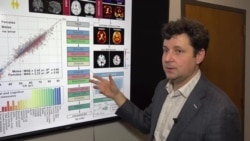ພວກນັກຄົ້ນຄວ້າໃນມະຫາວິທະຍາໄລພາກໃຕ້ຂອງລັດຄາລິຟໍເນຍ ຫລື USC ກໍາລັງໃຊ້ ການຖ່າຍພາບດ້ວຍສຽງສະທ້ອນແມ່ເຫຼັກ ຫຼື MRI ເພື່ອທຳການກວດ ຫລື ສະ ແກນສະໝອງ ເພື່ອຈະລະບຸອາຍຸທາງຊີວະພາບຂອງສະຫມອງມະນຸດ ຊຶ່ງອາດຈະ ບໍ່ກົງກັບອາຍຸຕາມປີການຂອງບຸກຄົນສະເໝີໄປ, ອີງຕາມທ່ານອານເດຣ ອີຣີເມຍ (Andrei Irimia), ຮອງສາດສະດາຈານໃນໂຮງຮຽນສຶກສາກ່ຽວກັບຜູ້ສູງອາຍຸເລໂອນາດ ເດວິສ (Leonard Davis) ຂອງມະຫາວິທະຍາໄລ USC.
ທ່ານອະທິບາຍວ່າ:
"ຖ້າຄົນອາຍຸ 45 ປີ ທີ່ມີສະຫມອງຂອງຄົນໃນໄວ 55 ປີນັ້ນ ກໍແມ່ນເປັນຍ້ອນການ ເລືອກເຟັ້ນໃນແບບແຜນດຳລົງຊີວິດທີ່ບໍ່ດີ ແລ້ວມັນກໍອາດເພີ້ມຄວາມສ່ຽງຕໍ່ການ ເປັນ ພະຍາດ ເພາະວ່າ ສະຫມອງທີ່ມີອາຍຸທາງດ້ານຊີວະວິທະຍາທີ່ແກ່ກວ່ານັ້ນ ປົກກະຕິແລ້ວ ຂ້ອນຂ້າງຈະເກີດການເຈັບປ່ວຍຫລາຍຫວ່າ ແລະມີຄວາມສ່ຽງສູງກວ່າຕໍ່ການ ເປັນພະຍາດທາງລະບົບປະສາດ ລວມທັງພະຍາດຫລົງລືມ ຫລື ອອລຊາຍເມີສ໌ ອີກດ້ວຍ (Alzheimer)."
ທີມງານ USC ໄດ້ນໍາໃຊ້ການຮຽນຮູ້ຂອງເຄື່ອງຈັກ ເພື່ອພັດທະນາໂຄງການທີ່ໄດ້ ຮັບການຝຶກອົບຮົມກ່ຽວກັບການຖ່າຍ MRI ຂອງສະຫມອງຜູ້ທີ່ມີສຸຂະພາບດີ 4,800 ຄົນ ເຊິ່ງຫຼັງຈາກນັ້ນກໍໄດ້ກວດເບິ່ງຄົນເຈັບ 300 ຄົນທີ່ເປັນພະຍາດທາງລະບົບປະສາດ. ຜູ້ຂຽນຊອບແວພອລ ບອກແດນ (Paul Bogdan) ໄດ້ເອົາແກ້ວຂະຫຍາຍ ທີ່ຂະຫຍາຍພາບຂອງເຂດຕ່າງໆ ທີ່ແຕກຕ່າງກັນຂອງສະຫມອງ ເຂົ້າໄປໃນໂຄງສ້າງ ການຮຽນຮູ້ຢ່າງເລິກເຊິ່ງຂອງໂຄງການດັ່ງກ່າວ.
ທ່ານພອລ ບອກແດນ (Paul Bogdan) ຈາກໂຮງຮຽນວິສະວະກຳ ວີເທີບີ (Viterbi) ຂອງມະຫາວິທະຍາໄລ USC ກ່າວວ່າ:
"ບົດບາດຂອງໂຄງສ້າງການຮຽນຮູ້ຢ່າງເລິກເຊິ່ງ ແມ່ນເພື່ອເບິ່ງແຕ່ລະເຂດຂອງສະໝອງໃນຊ່ອງສາມມິຕິ ເພື່ອຢາກຮູ້ວ່າ ເຂດສະເພາະໃດນຶ່ງປະກອບສ່ວນເຂົ້າໃນ ການຄາດຄະເນອາຍຸໄດ້ ຫລືບໍ່, ແລະຖ້າມັນເຮັດການຄາດຄະເນແລ້ວ ມັນກໍຍັງບອກຈຳນວນ ວ່າມັນສາມາດຊ່ວຍໃນການຄາດຄະເນອາຍຸຂອງສະໝອງໄດ້ຫລາຍປານໃດ ອີກດ້ວຍ.”
ທ່ານ ບອກແດນເວົ້າວ່າ ການຂະຫຍາຍພາບໃຫ້ໃຫຍ່ຂຶ້ນ ສາມາດຊ່ວຍໃນການ ວິໄຈ ຄວາມແກ່ຂອງສະຫມອງລະຫວ່າງຜູ້ຊາຍແລະແມ່ຍິງໄດ້ຫລາຍຂຶ້ນ ເພາະວ່າ ແຕ່ລະເພດ ແມ່ນມີການປ່ຽນແປງທີ່ແຕກຕ່າງກັນເກີດຂຶ້ນ ໃນເຂດຕ່າງໆຂອງສະຫມອງ. ພວກນັກຄົ້ນຄວ້າກ່າວວ່າ ການນໍາໃຊ້ທາງການແພດດ້ານອື່ນໆ ສໍາລັບການຮຽນຮູ້ເຄື່ອງຈັກອາດຈະເປັນ ການກວດເບິ່ງເມັດເລືອດທີ່ໄຫຼວຽນຢູ່ ເພື່ອລະບຸການເປັນໂຣກມະເຮັງ.
ອ່ານລາຍງານນີ້ເພີ້ມເປັນພາສາອັງກິດຢູ່ລຸ່ມນີ້:
Researchers at the University of Southern California are using machine learning to analyze brain scans to better predict diseases associated with aging. For VOA, Genia Dulot has the story from Los Angeles.
University of Southern California researchers are using magnetic resonance imaging, or MRI, scans to determine the biological age of a human brain, which may not always match a person’s chronological age, says Andrei Irimia, an assistant professor at USC Leonard Davis School of Gerontology.
Andrei Irimia, USC Leonard Davis School of Gerontology: “If a 45-year-old has the brain of a 55-year-old due to poor lifestyle choices, then that can also increase risk for disease because brains that are biologically older are typically a lot likelier to become ill and have higher risk for neurodegenerative disease, including Alzheimer’s disease.”
The USC team used machine learning to develop a program trained on 4,800 MRI scans of healthy brains, which was then tested on 300 patients with neurogenerative diseases. Software author Paul Bogdan integrated magnifiers that zoom in on different brain regions into the program's deep-learning architecture.
Paul Bogdan, USC Viterbi School of Engineering: “The role of deep learning architecture is to look at each region in a three-dimensional space, see if that particular region contributes to predicting the age, and, if it does, it also quantifies how much it can help to predict the age of the brain.”
Bogdan says that magnification allows for richer analysis of brain aging between men and women because each gender has different changes happening in different areas of the brain. Researchers say other medical uses for machine learning may be screening circulating blood cells to identify cancers.





